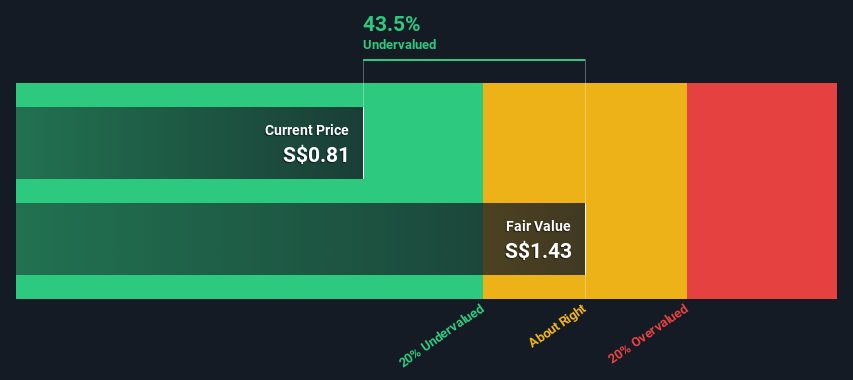Key Insights
-
Using the 2 Stage Free Cash Flow to Equity, Frasers Property fair value estimate is S$1.43
-
Frasers Property’s S$0.81 share price signals that it might be 44% undervalued
-
Our fair value estimate is 17% higher than Frasers Property’s analyst price target of S$1.22
How far off is Frasers Property Limited (SGX:TQ5) from its intrinsic value? Using the most recent financial data, we’ll take a look at whether the stock is fairly priced by estimating the company’s future cash flows and discounting them to their present value. The Discounted Cash Flow (DCF) model is the tool we will apply to do this. It may sound complicated, but actually it is quite simple!
Remember though, that there are many ways to estimate a company’s value, and a DCF is just one method. For those who are keen learners of equity analysis, the Simply Wall St analysis model here may be something of interest to you.
View our latest analysis for Frasers Property
Is Frasers Property Fairly Valued?
We are going to use a two-stage DCF model, which, as the name states, takes into account two stages of growth. The first stage is generally a higher growth period which levels off heading towards the terminal value, captured in the second ‘steady growth’ period. In the first stage we need to estimate the cash flows to the business over the next ten years. Seeing as no analyst estimates of free cash flow are available to us, we have extrapolate the previous free cash flow (FCF) from the company’s last reported value. We assume companies with shrinking free cash flow will slow their rate of shrinkage, and that companies with growing free cash flow will see their growth rate slow, over this period. We do this to reflect that growth tends to slow more in the early years than it does in later years.
Generally we assume that a dollar today is more valuable than a dollar in the future, so we discount the value of these future cash flows to their estimated value in today’s dollars:
10-year free cash flow (FCF) forecast
|
2024 |
2025 |
2026 |
2027 |
2028 |
2029 |
2030 |
2031 |
2032 |
2033 |
|
|
Levered FCF (SGD, Millions) |
S$714.1m |
S$635.7m |
S$590.9m |
S$565.4m |
S$552.0m |
S$546.2m |
S$545.7m |
S$548.7m |
S$554.4m |
S$561.8m |
|
Growth Rate Estimate Source |
Est @ -16.58% |
Est @ -10.98% |
Est @ -7.05% |
Est @ -4.31% |
Est @ -2.39% |
Est @ -1.04% |
Est @ -0.10% |
Est @ 0.56% |
Est @ 1.02% |
Est @ 1.35% |
|
Present Value (SGD, Millions) Discounted @ 11% |
S$642 |
S$513 |
S$429 |
S$368 |
S$323 |
S$287 |
S$258 |
S$233 |
S$212 |
S$193 |
(“Est” = FCF growth rate estimated by Simply Wall St)
Present Value of 10-year Cash Flow (PVCF) = S$3.5b
After calculating the present value of future cash flows in the initial 10-year period, we need to calculate the Terminal Value, which accounts for all future cash flows beyond the first stage. The Gordon Growth formula is used to calculate Terminal Value at a future annual growth rate equal to the 5-year average of the 10-year government bond yield of 2.1%. We discount the terminal cash flows to today’s value at a cost of equity of 11%.
Terminal Value (TV)= FCF2033 × (1 + g) ÷ (r – g) = S$562m× (1 + 2.1%) ÷ (11%– 2.1%) = S$6.2b
Present Value of Terminal Value (PVTV)= TV / (1 + r)10= S$6.2b÷ ( 1 + 11%)10= S$2.1b
The total value is the sum of cash flows for the next ten years plus the discounted terminal value, which results in the Total Equity Value, which in this case is S$5.6b. In the final step we divide the equity value by the number of shares outstanding. Compared to the current share price of S$0.8, the company appears quite undervalued at a 44% discount to where the stock price trades currently. Valuations are imprecise instruments though, rather like a telescope – move a few degrees and end up in a different galaxy. Do keep this in mind.
The Assumptions
The calculation above is very dependent on two assumptions. The first is the discount rate and the other is the cash flows. You don’t have to agree with these inputs, I recommend redoing the calculations yourself and playing with them. The DCF also does not consider the possible cyclicality of an industry, or a company’s future capital requirements, so it does not give a full picture of a company’s potential performance. Given that we are looking at Frasers Property as potential shareholders, the cost of equity is used as the discount rate, rather than the cost of capital (or weighted average cost of capital, WACC) which accounts for debt. In this calculation we’ve used 11%, which is based on a levered beta of 2.000. Beta is a measure of a stock’s volatility, compared to the market as a whole. We get our beta from the industry average beta of globally comparable companies, with an imposed limit between 0.8 and 2.0, which is a reasonable range for a stable business.
SWOT Analysis for Frasers Property
Strength
Weakness
Opportunity
Threat
Next Steps:
Valuation is only one side of the coin in terms of building your investment thesis, and it ideally won’t be the sole piece of analysis you scrutinize for a company. DCF models are not the be-all and end-all of investment valuation. Rather it should be seen as a guide to “what assumptions need to be true for this stock to be under/overvalued?” For example, changes in the company’s cost of equity or the risk free rate can significantly impact the valuation. Can we work out why the company is trading at a discount to intrinsic value? For Frasers Property, there are three pertinent elements you should look at:
-
Risks: For example, we’ve discovered 2 warning signs for Frasers Property (1 shouldn’t be ignored!) that you should be aware of before investing here.
-
Future Earnings: How does TQ5’s growth rate compare to its peers and the wider market? Dig deeper into the analyst consensus number for the upcoming years by interacting with our free analyst growth expectation chart.
-
Other Solid Businesses: Low debt, high returns on equity and good past performance are fundamental to a strong business. Why not explore our interactive list of stocks with solid business fundamentals to see if there are other companies you may not have considered!
PS. The Simply Wall St app conducts a discounted cash flow valuation for every stock on the SGX every day. If you want to find the calculation for other stocks just search here.
Have feedback on this article? Concerned about the content? Get in touch with us directly. Alternatively, email editorial-team (at) simplywallst.com.
This article by Simply Wall St is general in nature. We provide commentary based on historical data and analyst forecasts only using an unbiased methodology and our articles are not intended to be financial advice. It does not constitute a recommendation to buy or sell any stock, and does not take account of your objectives, or your financial situation. We aim to bring you long-term focused analysis driven by fundamental data. Note that our analysis may not factor in the latest price-sensitive company announcements or qualitative material. Simply Wall St has no position in any stocks mentioned.








